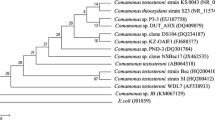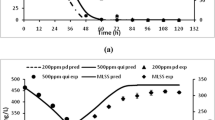Abstract
The Michaelis-Menten biodegradation kinetics (k and Ks) of aromatic compounds and trichloroethene (TCE) by an aerobic enrichment culture grown on phenol and dominated by a unique filamentous bacterium were measured. The average k and Ks values for phenol, benzene (B), toluene (T), ethylbenzene (E), o-xylene (oX), p-xylene (pX), naphthalene and TCE in g per g VSS-d and mg L-1 were 5.72 and 0.34, 1.20 and 0.51, 2.09 and 0.47, 0.77 and 0.23, 0.61 and 0.16, 0.73 and 0.23, 0.17 and 0.18, and 0.16 and 0.18, respectively. Significant variability in these measured kinetics was noted between tests conducted over the 5-month period during which the fed-batch culture with a 5-day solids retention time was maintained; the coefficient of variation of the k and Ks values ranged from 11–43% and 4–50%, respectively. This variation was significantly greater than the method measurement error on a given date. Degradation of BTEoXpX mixtures could be described by a basic competitive inhibition model.
Batch tests during which the culture was fed individual BTEX compounds showed the culture grew poorly on the xylenes and had poor subsequent xylene degradation rates. This work indicates the potential to simultaneously treat a mixture of volatile organic compounds using this consortium, and the ability to predict the mixture biodegradation rates on the basis of the individual compound biodegradation kinetics.
Similar content being viewed by others
References
Alvarez-Cohen L & McCarty PL (1991) Product toxicity and cometabolic competitive inhibition modeling of chloroform and trichloroethylene transformation by methanotrophic resting cells. Appl. Environ. Microbiol. 57(4): 1031–1037
APHA (American Public Health Association), AWWA & WPCF (1992) Standard Methods for the Examination of Water and Wastewater, 18th edn., Washington, DC
Bailey JE & Ollis DF (1986) Biochemical Engineering Fundamentals, 2nd edn, Section 3.2. McGraw-Hill, New York
Bielefeldt AR (1994) Cometabolic degradation of chlorinated aliphatics using a phenol-degrading enrichment. M.S. Thesis, University of Washington, Seattle, WA
Bielefeldt AR (1996) Biotreatment of contaminated gases in a sparged suspended growth reactor. Ph.D. Dissertation, University of Washington, Seattle, WA
Bielefeldt AR & Stensel HD (1998a) Evaluation of biodegradation kinetic testing methods and longterm variability in biokinetics for BTEX metabolism. Water Res. (in press)
Bielefeldt AR & Stensel HD (1998b) Modeling competitive inhibition effects during biodegradation of BTEX mixtures. Water Res. (in press)
Bielefeldt AR & Stensel HD (1998c) BTEX-contaminated gas treatment in a shallow, sparged, suspended-growth bioreactor. Bioremed. J. 1(4): 241–254
Bielefeldt AR, Stensel HD & Strand SE (1995) Cometabolic degradation of TCE and DCE without intermediate toxicity. ASCE J. Environ. Engrg. 121(11): 791–797
Broholm K, Christensen TH & Jensen BK (1992) Modelling TCE degradation by a mixed culture of methane-oxidizing bacteria. Water Res. 26(9): 1177–1185
Brown SC, Grady CPL & Tabak HH (1990) Biodegradation kinetics of substituted phenolics: demonstration of a protocol based on electrolytic respirometry. Water Res. 24(7): 853–861
Chang H-L & Alvarez-Cohen U (1994) Modeling product toxicity and competitive inhibition of cometabolic degradation of chlorinated organics. Presented at the Water Environment Federation 67th Annual Conference and Exposition. Chicago, IL, #AC944703
Chang M-K, Voice TC & Criddle CS (1993) Kinetics of competitive inhibition and cometabolism in the biodegradation of benzene, toluene, and p-xylene by two Pseudomonas isolates. Biotech. and Bioengrg. 41(11): 1057–1065
Criddle CS (1993) The kinetics of cometabolism. Biotech. and Bioengrg. 41(11): 1048–1056
Deeb RA & Alvarez-Cohen L (1994) Degradation of BTEX compounds: temperature and mixture effects. Presented at the Water Environment Federation 67th Annual Conference and Exposition. Chicago, IL
Ellis TG, Barbeau DS, Smets BF & Grady CPL (1996a) Respirometric technique for determination of extant kinetic parameters describing biodegradation. Water Env. Res. 68(5): 917–926
Ellis TG, Smets BF, Magbanua BS & Grady CPL (1996b) Changes in measured biodegradation kinetics during the longterm operation of completely mixed activated sludge (CMAS) bioreactors. Water Sci. Technol. 34(5/6): 35–42
Folsom BR, Chapman PJ & Pritchard PH (1990) Phenol and trichloroethylene degradation by Pseudomonas capacia G4: Kinetics and interactions between substrates. Appl. Environ. Microbiol. 56(5): 1279–1285
Fox BG, Borneman JG, Wackett LP & Lipscomb JD (1990) Haloalkene oxidation by the soluble methane monooxygenase from Methylosinus trichlosporium OB3b: mechanistic and environmental implications. Biochemistry 29(27): 6419–6427
Grady CPL, Smets BF & Barbeau DS (1996) Variability in kinetic parameter estimates: a review of possible causes and a proposed terminology. Water Res. 30(3): 742–748
Guerin WF & Boyd SA (1992) Differential bioavailability of soilsorbed naphthalene to two bacterial species. Appl. Environ. Microbiol. 58(4): 1142–1152
Howe GB, Mullins ME & Rogers TN (1988) Evaluation and production of Henry's law constants and aqueous solubilities for solvents and hydrocarbon fuel components, Vol. I: Technical discussion. Final Report Engineering Services Lab., Tyndall AFB, Report No. ESL–86–66
Jandel Scientific Software (1995) SigmaPlot Scientific Graphing Software, Version 5 for Macintosh
Kader S (1995) Bioaugmentation of polycyclic aromatic hydrocarbon degradation and treatment of contaminated soils and sludge. M.S. Thesis, University of Washington, Seattle, WA
Landa AS, Spikema EM, Weijina J, Beenackers AACM, Dolfing J & Janssen DB (1994) Cometabolic degradation of trichloroethylene by Pseudomonas cepacia G4 in a chemostat with toluene as the primary substrate. Appl. Environ. Microbiol. 60(9): 3368–3374
Liu Y-T (1994) Enhancement of polyaromatic hydrocarbon degradation in the marine environment. M.S. Thesis, University of Washington, Seattle, WA
Machado RJ & Grady CPL (1989) Dual substrate removal by an axenic bacterial culture. Biotech. and Bioengrg. 33(1): 327–337
Oh Y-S, Shareefdeen Z, Baltzis BC & Bartha R (1994) Interactions between benzene, toluene, and p-xylene (BTEX) during their biodegradation. Biotech. and Bioengrg. 44(4): 533–538
Saez PB & Rittman BE (1993) Biodegradation kinetics of a mixture containing a primary substrate (phenol) and an inhibitory co-metabole (4-chlorophenol). Biodegradation 4: 3–21
Schwarzenbach RP, Gschwend PM & Imboden DM (1993) Environmental Organic Chemistry. John Wiley, New York
Shields MS, Reagin MJ, Gerger RR, Somerville C, Schaubbut R, Campbell R & Hu-Primmer J (1994) Constitutive degradation of trichloroethylene by an altered bacterium in a gas-phase bioreactor. In: Hinchee RE, Leeson A, Semprini L, Ong SK (Eds) Bioremediation of Chlorinated and Polycyclic Aromatic Hydrocarbon Compounds (pp 50–65). Lewis Publishers, Boca Raton, FL
Smith MR (1990) The biodegradation of aromatic hydrocarbons by bacteria. Biodegradation 1: 191–206
Stensel HD & Bielefeldt AR (1997) Anaerobic and aerobic degradation of chlorinated aliphatic compounds. In: Bioremediation of Hazardous Wastes: Principles and Practices, Vol. 2. Technomics Publishers, Lancaster, PA
Strand SE, Bjelland MD & Stensel HD (1990) Kinetics of chlorinated hydrocarbon degradation by suspended cultures of methane-oxidizing bacteria. J. WPCF 62(2): 124–129
Strand SE, Seamons RM, Bjelland, MD & Stensel HD (1988) Kinetics of methane-oxidizing biofilms for degradation of toxic organics. Water Sci. Technol. 20(11/12): 167–173
Templeton LL & Grady CPL (1988) Effect of culture history on the determination of biodegradation kinetics by batch and fed-batch techniques. J. WPCF 60(5): 651–658
Tittle PC (1994) PAH degradation by PAH-degrading enrichments after growth with alternate substrates. M.S. Thesis, University of Washington, Seattle, WA
Wackett LP & Householder SR (1989) Toxicity of trichloroethylene to Pseudomonas putida F1 is mediated by toluene dioxygenase. Appl. Environ. Microbiol. 55(10): 2723–2725
Yoon J, Klinaing G & Blanch HW (1977) Competition for mixed substrates by microbial populations. Biotech. and Bioengrg. 19: 1193–1210
Zylstra GJ (1994) Molecular analysis of aromatic hydrocarbon degradation. In: Garte SJ (Ed) Molecular Environmental Biology, Chap. 5. Lewis Publishers, Boca Raton, FL
Author information
Authors and Affiliations
Rights and permissions
About this article
Cite this article
Bielefeldt, A.R., Stensel, H.D. Biodegradation of aromatic compounds and TCE by a filamentous bacteria-dominated consortium. Biodegradation 10, 1–13 (1999). https://doi.org/10.1023/A:1008327006308
Issue Date:
DOI: https://doi.org/10.1023/A:1008327006308




